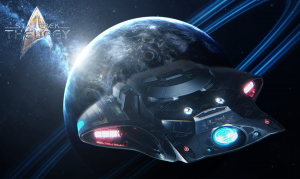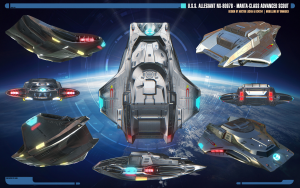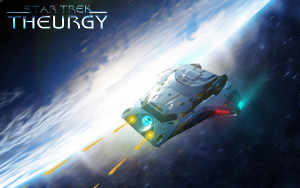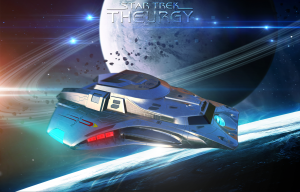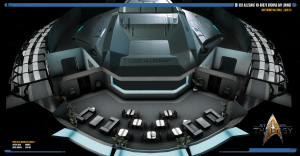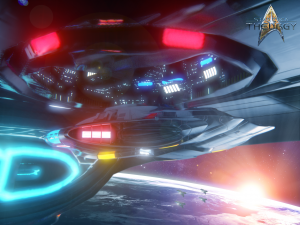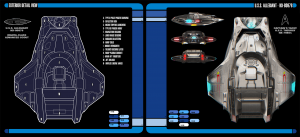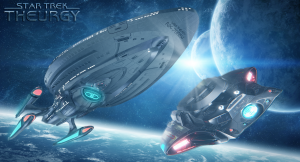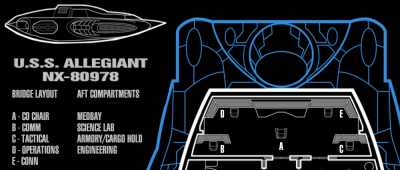USS Allegiant NX-80978
From Star Trek: Theurgy Wiki
Designated as a Manta-class Advanced Scout, like many of the other things stationed on the USS Theurgy, this scoutship was an experimental prototype. When it was decided that the Theurgy would serve as an experimental testbed for both a fighter squadron of the new Mk III Valkyries and for a new system of computer interface (the Ship A.I.) it was decided that for a auxiliary craft, they would integrate a prototype for the newest in the aerowing-series of scouting vessels into the hull of the saucer.
It was an augmented version of the Talon-class scout, refereed to as Project Manta by the Advanced Starship Design Bureau. Just like it's registry, the prototype was also given an official name besides 'the Yacht', and that was the USS Allegiant (commonly ref. as "the Yacht").
Scoutship Demonstration
Project Manta
The Allegiant was the culmination in a long line of mission-specialized auxiliary craft starting with earlier development of the Peregrine-class Federation Attack Fighter. The successful deployment of this ship for patrols near the Cardassian DMZ led to the development of a hybrid Runabout-fighter geared towards atmospheric flight and combat but also equipped with specialized sensor packages allowing for detailed planetary scans. This project led to the aerowing-design, though it never gained much widespread use. The Intrepid and the first of the Luna-class starships, however, had aerowing shuttles as auxillary crafts mounted underneath their saucers.
The aerowing's advanced sensor package and atmospheric capabilities were further fine-tuned into the development of the Talon-class scout ship, which had gained much more widespread use within the Federation as a deep-space reconnaissance craft and as a medium sized military transport. Given the Talon's advanced sensors and its capabilities to be further amplified, small sleets of these crafts could be deployed along the Federation's various neutral zones to aide in the detection of cloaked ships.
Another notable accomplishment of the Talon-class was how its size and flight-profile was used in the development for the first wave of experimental fighters in the Valkyrie-project. With the commissioning of a Mk III iteration of the Valkyrie warp fighter, the Talon-class scout ship was becoming outclassed and it was becoming apparent that in an arms-race where a single fighter could potentially destroy the scout, improvements were required to be made in order to keep the shuttle-series a viable tactical choice.
It was with this in mind that development began on the first prototype of a new Exploration Scout. The shuttle would be viable for much longer mission lengths and would house a larger crew while still retaining some of the aerowing design that had made the series excel in atmospheric situations. It was decided that in lieu of a standard Talon-class scout being embedded into the USS Theurgy’s hull as an auxiliary craft, the Theurgy would have its hull modified to have the new Manta-class scoutship instead.
Tactical Systems
2 Type U Pulse Phaser Cannons
A relatively new development in phaser technology, the Type U pulse phaser was the most combat-focused development of the phaser to date. It combined large, nearly flawless emitter crystals with rapid-discharge EPS banks and high-speed beam focusing coils. The system allowed the charge to be stored in the coils for a few nanoseconds, then released it as a layered pulse. Due to its nature, shields and armour had a harder time dispersing the pulse, resulting in more damage to the target. Type U pulse phasers were first deployed on the USS Defiant, and while the Manta-class scoutship was much smaller in size, technological advancement since the construction of the Defiant allowed the system to be downscaled sufficiently to fit. Like in the Defiant, the warp drive plasma conduit ran through the primary phaser coupling to double the power of the scoutship’s cannons.
4 Type VII Phaser Arrays
These were the largest emitters used on small craft such as runabouts and light escorts. The four Type VII phaser arrays, two in front and two in the aft, were the Manta-class scoutship's secondary firing option after the Type U pulse phasers.
3 Micro Torpedo Launchers
The Allegiant had three Mk 27 micro torpedo launchers, which had 55-round magazines with 50cm Type V micro-torpedoes each. Two were mounted in the front and one in the aft. With the power consumption of the Type U pulse phasers, the Allegiant was restricted to micro torpedo launchers instead of full-sized ones.
Tetryon Pulse Sensor Probe
Part of the advanced Manta Project, this probe used tetryon pulse technology. The primary use of this probe was to fire into an area where it was suspected that cloaked ships may wish to enter into Federation space.
Once launched the probe began to emit tetryon pulses which reflect off most cloaking systems (various types of phase cloaks are exceptions to this method of detection). The Allegiant was outfitted with a special sensor array designed to be able to detect even the most minute of these tetryon pulse reflections and therefore was well suited to carry a tetryon pulse probe into an area. Once launched, the craft could then monitor the area for potential cloaked vessels.
Interior Layout
For sake of reference to the locations described, please check the deck plan below:
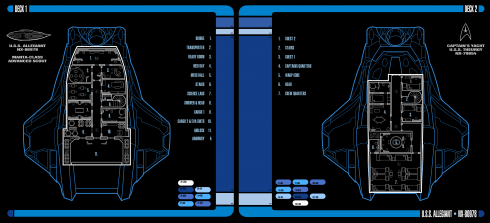
DeviantArt full resolution view: https://auctor-lucan.deviantart.com/art/U-S-S-Allegiant-LCARS-Interior-View-561924479
Upper Deck
- Bridge
- The bridge was mission configurable for 1,2, 4 or 5 person setups. It held one central seat with two control stations behind it (Communications & Tactical), and two in front (Ops & CONN). As a general rule - like the CONN of a starship - the pilot's job was to fly the Allegiant. If there was no one at Tactical then the pilot flied, controlled weapons, and controlled shields, similar to the role of a Tactical CONN officer when piloting a warp fighter.
- Transporter Room
- This small room features a five man transporter and a transporter console. In practice, the four outer pads were used for personnel and the central pad was used for cargo. The yacht’s transporter had all of the benefits and limitations of a standard 24th century transporter including a range of 40,000 kilometers.
- Ready Room
- If the captain is not aboard the yacht, the Captain's Ready Room and his quarters are locked and are not to be entered. If the captain wishes for the ranking officer of the ship to be given the use of the Captain's luxuries, then it is the Captain’s right to grant that single officer access for duration of the mission.
- Medical Bay
- This cramped medical bay holds one biobed as well as cabinets that hold medical instruments and equipment. A desk is available for the medical officer or specialist onboard. Surgery is possible but not recommended.
- Mess hall
- Small crew lounge with basic replicator and five small two man tables. The lounge can also be converted to room for additional passengers.
- Science Labs
- The central lab table contains cabinets that are stocked with a variety of scientific instruments. It also features holoprojectors to display what is being studied on the table or at any of the four workstations in the room. The equipment here, like much of the other rooms aboard the yacht is modular for quick swapouts for changing mission objectives.
- Shower & Head
- Each deck of the yacht contains a head complete with a sink and a toilet that breaks down organic waste into organic molecules that are stored as a resource. The head on the top deck has a sonic shower with a hydronic resequencer that can emit streams of pure water should the user desire.
- x 2 Cargo holds
- The cargo bays could be easily converted into passenger quarters by moving bunk cots as beds, and the starboard hold features the locker containing the scoutship's EVA-suits.
- Airlock
- The large airlock on the aft side of the top deck functions as an additional cargo hold. The twin consoles can open and close the doors, set up a defensive force field or a more porous magnetic field that allows solid and liquid matter egress while maintaining atmospheric integrity, or extend a ramp down the back of the scout ship for passenger embarkation during planetary landings.
- Armory
- The Manta class' armory consisted of six lockers containing a full set of phasers, including a concealable hand phaser, a utilitarian phaser pistol, and the heavy combat phaser rifle. Grenades, combat tricorders, bayonets, and webgear could be stored in each locker but were not standard. On later missions, the Allegiant’s armory held additional equipment such as antinadion flashbangs, SAFTI Gear, and the RG-TR1506 Accipiter heavy support rifle that was reversed engineered from early 25th technology.
Lower Deck
- x 2 Guest Quarters
- The starboard side of the lower deck held two guest rooms that were available for officers or VIP guests that wouldn't be comfortable in the crew quarters. Many times the commanding officer of the yacht would take one of these rooms in order to free up captain's quarters for a visiting VIP. Although cramped by 24th century standards, the guest rooms contained a bunk, a wardrobe, a desk and a divan for socializing.
- Captain's Quarters
- The portside of the lower deck featured a suite of small rooms intended for commanding or flag rank officers. A head containing a sonic shower that could emit water if desired, small bedroom containing a full sized bed, wardrobe, and drawers, and a larger room to entertain guests was provided. A desk, a table capable of seating six, a couch, a divan, a coffee table and end table were standard as well as a holoemitter installed in one corner of the ceiling for media and entertainment.
- Warp core room
- As a warp capable ship, the Manta class had a shielded engineering room with six workstations and a central warp core that could be jettisoned in emergencies.
- Head
- The head on the lower deck, accessible from the crew's bunkroom did not feature a sonic shower.
- Crew Quarters
- On the lower deck, aft section, a spartan crew quarters for 18 could be found. In a pinch the chamber was easily converted into an additional cargo hold if desired.
Master System Display
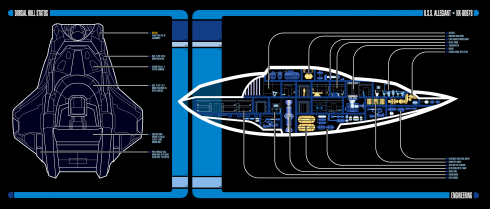
DeviantArt full resolution view: http://auctor-lucan.deviantart.com/art/U-S-S-Allegiant-NX-80978-LCARS-MSD-622681842
